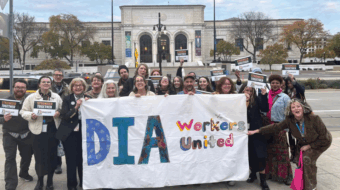
Why can’t they be like we were, perfect in every way?
What’s the matter with kids today? (“Kids” – Bye Bye Birdie)
We are living in times that are increasingly challenging for young people who are trying to be free and idealistic, but are fed up with war, greed, government corruption and the possible destruction of the earth they are supposed to inherit. Many are choosing options that have failed consistently in the past, using tactics that helped bring us to these untenable straits. Some choose violence to correct the wrongs of the past and it’s starting to draw attention once again.
One of the main themes at this year’s Western Hemisphere cinematic spectacular, the Toronto International Film Festival (TIFF), was the resurgence of young “terrorists.” There seems to be a great deal of concern about why anyone would be enticed to join a violent group opposed to the democratic West with all its freedoms and material gains. It would take a book to try to define these loaded political terms – freedom, democracy, terrorism – but one common adage, “One man’s terrorist is another man’s freedom fighter,” has been used by leaders from Reagan to Arafat to justify violence. In one case it’s to defend the Empire, in the other to fight off the oppressor and its occupying forces. Is a “just” war an oxymoron? Leftists for years made the distinction between wars initiated by the oppressor and those by the oppressed, capitalist wars and wars of liberation.
At least three well-made French films at TIFF 2016 addressed these concerns, each representing distinct class segments of society. The bold and alarming acton thriller Nocturama follows seven diverse young Parisians drawn together by undefined circumstances. The first half of the film, mostly free from dialogue, follows their intricately timed maneuvers of passing off and planting bombs throughout the city. The second half covers them holed up in a luxurious building dealing with the aftermath of their extreme actions. How did they meet each other? What did they have in common? Why were they bombing? Seemed they all assumed they weren’t going to survive. It’s a stylish political thriller, with more emphasis on “stylish.”
In Layla M, a young Muslim girl living in Amsterdam confronts the realities of Islamophobia. While deepening her faith in Islam she is radicalized by the injustice she sees around her. Enticed by jihadists on the Internet, she rebels against her “assimilating” parents and eventually moves to the Middle East with a new husband to practice “true” Islam. What makes the film intriguing is what happens next.
Another French film, with a similar theme, Heaven Will Wait, addresses identical issues, but now it’s French girls being enticed by “extreme Islam,” and here they are forced to attend de-programming classes run by mainstream Muslims who support Western ideals of capitalism, democracy, freedom, tolerance, diversity, and American empire. They are reminded that the hijabs is a concoction of reactionary Wahhabis, and that the style of religion they choose to practice is not “kosher.”
One feels a sense of Islamophobia in these stories, especially with France having to deal recently with so many terrorist acts. But remember, the French have a sordid history of using torture to deal with Muslims in their colonial exploits in Algeria. This movie felt like an attack on Islam by implying that there are only two choices, either support the West or join the jihadists and die. What’s wrong with another option – progressive Muslims opposed to capitalism?
And then there’s our own homegrown American “terrorists” – all types – whether they come from the privileged bourgeoisie à la Patty Hearst or the disenchanted racist right wing à la Timothy McVeigh. A famous 1997 novel by Philip Roth is the basis for Ewan McGregor’s first directorial attempt, American Pastoral (trailer here). In this case it’s from the point of view of upper-class Jewish parents, an industrial factory owner (McGregor) who boasts of hiring 80 percent Negroes, and his Miss New Jersey beauty queen wife. They are dealing with a young daughter who stutters and by the age of 16 becomes a radical terrorist. They lose touch with her and discover she bombed the local small town post office, killing an employee. No subtle reference to the Weather Underground, she becomes a hunted fugitive. The loving father, Swede, never gives up trying to find his daughter, while the mother tries to forget about the whole thing through plastic surgery and new boyfriends.
It’s a personal story about family relations during the turbulent political times of the 1960s. Without spoiling the story, there is a suggestion that she has joined the Indian Jain religion, whose adherents wear masks over their mouths, refuse to harm any living thing, and live as recluses. It’s a very appealing visual representation of one of America’s best-selling books, a 1998 Pulitzer Prize winner.
If you equate “terrorist” with radical revolutionary, then the film that made the most noise and press was the provocatively titled Those Who Make Revolution Halfway Only Dig Their Own Graves. This bold, offensive and extreme assault on the senses was considered an artistic triumph and voted as the Best Canadian Feature at TIFF. Immediately challenging the audience by running a black screen with loud marching brass band music for what seemed like infinity, only to shock the viewers when light eventually returned to the screen, the film continued to make cinematic revolution. Utilizing footage from the Montreal student tuition protests of 2012, the story goes on to follow young radicals searching for antidotes to today’s malaise and continual social disintegration, and for an effective response to corporate takeover of public spaces and the massive state forces being used against protestors.
This visual and cinematic experiment was difficult to watch at times: Patrons began fleeing from the packed theater once the nudity, violence, senseless bombings and extended long takes became unbearable. The film challenges conventional continuity, lighting and dialogue while boldly mixing film formats, often reminding of Jean Luc Godard’s bold experiments with titles, casting and radical storyline.
But ultimately it was hard to sense the message: Was it mocking students and their seemingly aimless and futile actions, or defending protest and sending a revolutionary message? At over 3 hours it was the longest film ever from Quebec and took courage for TIFF and its Director Piers Handling to put it in the festival. Amazingly, the film went on to win the top Canadian prize “for its uncompromising, electrifying portrait of youthful idealism and democratic exhaustion in contemporary Canada, and for its capacity to stir both heart and mind.” Goes to show you!
So maybe we ought to stop using the term “terrorist” to loosely define all our enemies. Terror is not an ideology or religion. It’s a tactic to win a battle, however good or bad. In one case to get out from under the oppressor’s boot – in the other case, to take over the world. We still can learn something from old KM:
“The war of the enslaved against their enslavers is the only justifiable war in history…. There can be no doubt as to who the victor will be in the end – the appropriating few, or the immense working majority.” – Karl Marx, The Civil War in France










